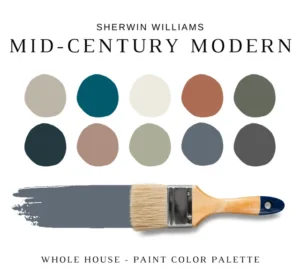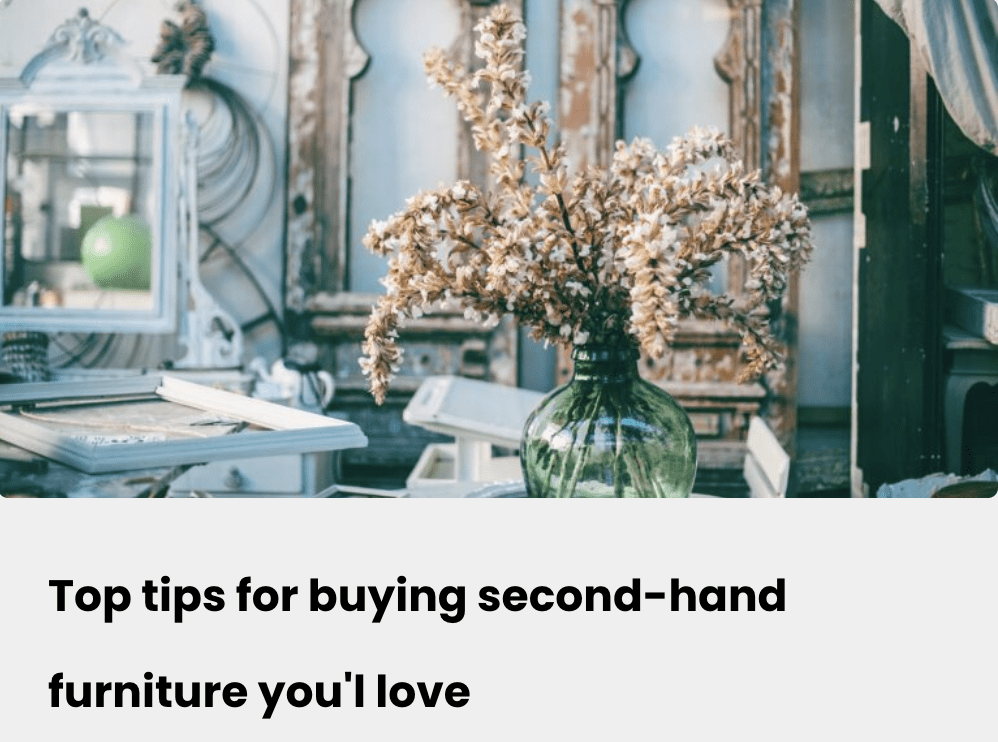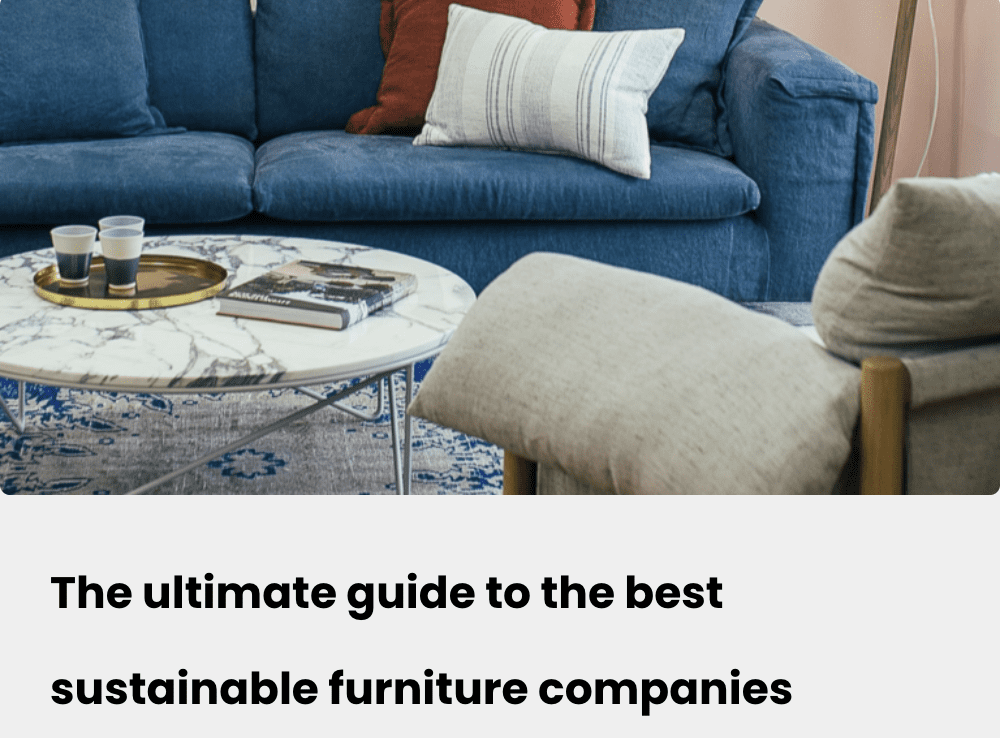In this post: I look at how you can add sustainable, mid-century interior design to your home.
The origins of mid-century modern interior design
Mid-century modern (MCM) was a design style before its time which is perhaps why it’s still so popular almost 100 years after it began. The idea behind the development of mid-century modern interior design was to create high-quality, affordable items for the sizable and growing middle class of the post-World War II era.
One of the key ideas that revolutionized the style was a focus on functionality over purely decorative ornamentation. Mid-century modern designers celebrated minimalism, a revolutionary idea in a time when ostentation had previously been the height of fashion.
Just because mid-century pieces were built with functionality in mind, however, doesn’t mean they weren’t fun. The use of organic objects brought an element of fun to mid-century pieces, and designers of this style were known for their use of bold, untraditional colors.
If you love this style, but are wondering how to work a mid-century vibe into your home, read on!
Article contents
-
9 tips for incorporating mid-century interior design into your home
-
8 mid-century furniture pieces to know
-
Famous mid-century decorative pieces
-
Artwork styles to pair with mid-century modern interior design
-
The link between mid-century modern interior design and sustainability
-
Sustainable mid-century modern furniture makers
9 tips for incorporating mid-century interior design into your home
1. Decide if you’re a purist


Before you begin, assess your end goal. Are you a historical design aficionado interested in representing mid-century modern interior design as it was originally envisioned? Do you want to take a more modern approach with updated color schemes and designs that may not have been available decades ago? Or, finally, if you’re more like me, you admire the mid-century style but don't want to stick to just one style. If this is you, you may be happier strategically selecting a few mid-century pieces and working in other styles as well.
2. Declutter
One of the things that I believe has made mid-century modern design so appealing for such an extended amount of time is the way it makes people feel. The clean lines and simple shapes give you the space to relax and take a deep breath. When you look at the way classic mid-century interiors, they are organized and functional and they feel up to the task of performing well in everyday life.
Even if you’re not ready to refurbish your whole home with mid-century modern interior design, you can still embrace this idea. I am not tidy by nature but I find decluttering is worth the effort in terms of the piece of mind that it creates.
3. Embrace organic
The originators of mid-century design and furniture sought to work with nature and embraced organic shapes and materials. Using natural materials is a huge step toward achieving a mid-century modern interior design in your home.
A great place to start is with furniture and textiles which are readily available using natural fibers. While the original mid-century modern aesthetic relied heavily on plastic, which was a new material at the time, there are now even better options available. Many home goods makers are producing items using recycled and recyclable materials like HDPE or plant-based plastics like PLA.
4. Use those bold colors
One of the hallmarks of the original mid-century modern interior design scheme was the use of bold colors like avocado, mustard, and rust. Using those colors will pretty quickly convey a vintage feel.
If that’s not your thing, try using bold colors but ones that are more common in today’s home like more muted blues and greens with maybe an accent color thrown in. Which brings us to our next tip…


5. Limit your color palette and carry it throughout your home
Image courtesy of eDesign by Nish
To make your home feel cohesive and unified, pick a color scheme and use some variation of that palette throughout your home. You may naturally gravitate toward one color family. If not, there are a few sources you can consult for help.
One of my favorite places to go for great decor color tips is Etsy. Many interior designers will post color palettes on Etsy that have worked for them in the past. If you see something you like, you can purchase the exact color names for a pretty reasonable price.
Check out eDesign by Nish for more details on this gorgeous mid-century modern palette.
6. Consider the classics
Vintage mid-century modern pieces can be pricey but that doesn’t necessarily mean you are priced out of the market. One idea is to splurge on an iconic piece like an Eames chair or Naguchi coffee table but save money elsewhere. Or, if splurging is not in the budget, consider some modern designs inspired by the masters.
7. Don’t forget the artwork
One of the biggest mistakes I see is abandoning your interior design aesthetic when it comes to artwork. While contrast and an eclectic vibe can be great, make sure that when you are “breaking a rule” or working outside your original design plan, it’s intentional.
(By the way, if you're interested in learning more about this piece of art, it's owned by the Birmingham Museum of Art. Check out this interesting article on its creator, Jessica Dismorr.)


Superimposed Forms, 1938. Artist: Jessica Dismorr d. 1939. Birmingham Museums Trust.
8. Do it for the kids
Considering the next generation can take a lot of forms. One way is to try not to use more than our fair share of resources so that future generations have the same opportunities that we do. There are quite a few fantastic furniture and home goods brands that focus on mid-century modern design so you don’t have to worry about struggling to find sustainable options that you’ll love.
Another way to consider future generations is by making sure you are buying quality items. Mid-century style has become a modern classic and chances are it’s a design style that will continue to have appeal into the future. Maybe your kids will actually want their parents' vintage furniture or maybe a stranger will get just as excited as you about that beautiful mid-mod credenza. By making sure something has the capacity to last for decades, you’re opening up more options for future design lovers.
9. Know the brands
A great way to make interior design easy on yourself is to find the brands that fit your style and start there. Narrowing the field of options can be a great way to more quickly find what you need and not make yourself crazy. And when it comes to mid-century modern interior design, your options are fantastic.
Icons of mid-century modern style
8 mid-century furniture pieces to know
One of the easiest ways to convey a mid-century modern aesthetic is by including easily recognized mid-century designs in your home. The following are some of the best-known and most popular mid-century modern furniture designs, as well as some pieces inspired by these well-known icons.
1. Eames lounge chair and ottoman
The Eames chair, created by Charles and Ray Eames in 1956, may well be one of the best-known pieces of mid-century modern furniture in existence. It’s not just super cool looking but, in adherence with MCM principles, does a great job functioning as a comfy place to relax. Originals can sell for hefty sums of money but over the years there have been many designers inspired by the Eames brothers whose furniture is more accessible.
2. Eames Molded Plastic Chair
This is another very recognizable classic from the Eames brothers, and actually pre-dates the lounge chair and ottoman. This molded plastic style is so ubiquitous these days, you may not have even known it started with one iconic design. The original was created utilizing molded fiberglass and plastic to create a shell-like seat in an organic shape characteristic of mid-century modern design.
3. Noguchi Coffee Table
Sculptor Isamu Noguchi created this modern masterpiece in 1944. Its organic shapes and timeless materials have blended well with contemporary design for the last 8 decades – which may explain its immense and sustaining popularity.
4. Barcelona Chair
This elegant icon is almost 100 years old. Its simple, elegant design still lends a modern feeling to any space it occupies. The chair was originally created by Mies van der Rohe and Lilly Reich for the German Pavillion at the 1929 Barcelona Exposition (hence the name). It has remained a symbol of modern design ever since.
5. Saarinen Tulip Table
Although I don't know the origin of the name, it seems fitting since the smooth, minimalist shape of the tulip table is as graceful as a tulip itself. It’s such a classic that it’s been successfully paired with a variety of chair types and interior design styles since its creation in the 1950s by Eero Saarinen.
6. Arne Jacobsen Egg Chair
You may or may not be aware of this exact furniture icon, but you’ve certainly seen some of the predecessors that this classic has inspired since its birth in 1958. It was designed by Arne Jacobsen and aptly named the Egg Chair due to its ovular, enveloping shape.
7. George Nelson Marshmallow Sofa
Created by George Nelson in 1956, the Marshmallow Sofa is so playful and edgy that it’s another piece that’s hard to believe has been around for decades.
8. The credenza
The credenza is a classic part of many mid-century modern interiors and it’s versatility means it can be useful in just about any room in your home. While there are quite a number of popular mid-century modern credenza, perhaps the most famous is the Nelson Thin Edge Credenza designed by George Nelson.
Famous mid-century decorative pieces
If you’re not ready to invest in a new piece of furniture but want to work some mid-century style into your home, decorative items might just be the thing you need. Below are some of the best known mid-mod home goods.
Danish modern teak accessories
Danish modern and Danish Teak were important trends within the mid-century modern style. Adding Danish modern decorative elements such as candle holders and salt and pepper shakers are a great way to incorporate some MCM style into your home.
Artwork styles to pair with mid-century modern interior design
Because of its straightforward, clean design aesthetic, mid-century modern furniture and decorative elements can mesh well with a variety of art styles. A few painting styles that are particularly well-known for working with mid-century style include:


Abstract expressionism
The wild expressiveness of paintings by artists like Jackson Pollock and Willem de Kooning sit in interesting contrast to the quieter elegance of mid-century furniture. It’s perhaps that balance that makes these two styles such a successful pairing.
Pop-art
This is another demonstration of the effectiveness of balance in design. The loud, bold imagery and color in Pop Art works show up well against the serenity and simplicity of mid-century design.
Color Field paintings
Mark Rothko is the best-known color field painter but some other favorites include Helen Frankenthaler and Morris Louis. Colorfield paintings use large fields of color as the primary mode of expression to evoke a mood or convey an emotion.
3-dimensional masters from the mid 20th century
Sculpture lends itself well to the organically inspired mid-century modern aesthetic. Some of the most famous sculptures often paired with this style include:
- Isamu Noguchi – It’s not hard to believe that Isamu Noguchi, the creator of the iconic Noguchi coffee table, was also a sculpture. His instinctive understanding of three-dimensional form is obvious and likely the reason his furniture and sculptural designs are so beloved.
- Alexander Calder – Alexander Calder was the genius behind the mobile that inspired so many who came after him. He was also prolific in 2D art forms, most often sticking to his signature primary color palette with heavy use of black accents.
- Henry Moore – Henry Moore’s best-known sculptures represent abstracted recreations of the human form. Despite their voluptuousness, the interaction with negative space makes his work feel connected to the space around it. These elements of connectedness and natural shape make his sculptures a harmonious fit with mid-century decor.
The link between mid-century modern interior design and sustainability


Need another great reason to love mid-century modern interior design? For me, it's sustainability.
One of my favorite things about the mid-century style is the way that sustainability is really built into its core principles. In many ways, the ideas of mid-century modern interior design can be seen as a precursor to the focus on sustainability that we see in interior design today.
One important way that mid-century design has sustainability at its core is through the importance of simplicity. Maybe you’ve heard about slow interior design, or minimalist living. The OGs of mid-century modernism were also some of the first to popularize the idea of focusing on what you need instead of excess. I could write a dissertation here about form following function but I’ll save you the details and just share that architects and designers working in modern styles in the mid-20th century were big fans of keeping things simple and designing with intent.
In addition, mid-century materials are naturally (no pun intended) more eco-friendly. Not only are organic shapes an important part of what makes the mid-century style distinctive, but in addition, designers who adopted this style relied heavily on natural materials in their interiors like wood, stone, and natural fibers.
Sustainable mid-century modern furniture makers
Some of the most progressive sustainable furniture companies today are the same ones who are continuing to carry the mid-century design torch.
Room & Board
“We design our own furniture, taking inspiration from enduring design movements of the past. You’ll find pieces inspired by Shaker designs; Scandinavian and Mid-century Modern furniture; Japanese styles; and the American Arts and Crafts movement.”
Room & Board is a great source to look to for cues on how to incorporate mid-century into a multifaceted modern home. Mid-century style feels like the basis for many of their furniture pieces and room designs but it blends well with other styles. The blended look that Room & Board achieves breathes new life into MCM designs and gives you the opportunity to find the right MCM-inspired design style for your personal taste.
West Elm
“At West Elm, we’re here to help you create a space that reflects you and what you love. That means forward-thinking, problem- solving design that unites value, quality and responsible manufacturing.”
West Elm’s style is strongly rooted in a mid-century sensibility, one feels somehow both current and a nod to the past. West Elm also offers a range of sustainably sourced furniture options. They have a program called “Fair Trade Certified” which ensures that their products are made with fair labor practices and environmentally friendly materials.
Medley
“Sometimes to go forward, you have look back. How did a piece of furniture get made 150 years ago, before mass production and overseas shipping? We wanted our workshop to be more like that (with a few modern tweaks, of course). All our furnishings are handcrafted right here in the USA, and each piece is made especially for you when you order it.”
Medley does mid-century cool in a way that is designed to look as good in the future as it does now. While they are a newer kid to the mid-century block, their thoughtful designs and well-crafted furniture would blend seamlessly into any mid-century interior.
Emeco
“Emeco was founded on the principle, ‘Begin with what's left over. Turn it into what will last.' Our first chair, the classic 1006 Navy Chair was made from scrap material and built to last at least a hundred and fifty years – because that was the best we could do. Today we continue to lead the industry, exploring and innovating ways to use consumer and industrial waste, and environmentally responsible resources to create and build simple, timeless furniture that lives up to the standards that we inherited from our founders.”
You may not recognize the brand name but you’ve surely seen and probably sat in a recycled aluminum Emeco chair. They’ve been making furniture since 1944 with the idea of form following function solidly embedded in their DNA. The result is furniture that is beautifully simple and practically timeless.
Knoll
“We use modern design to connect people to their work, their lives, their world. Since 1938, we have been recognized internationally for creating workplace and residential furnishings that inspire, evolve, and endure. Today our commitment to modern design, our understanding of the nature of work, and our didication to sustainable design have yielded a unique portfolio of thoughtful products that respond and adapt to changing needs.”
Knoll has an impressive heritage, dating all the way back to 1938. It was founded in the Bauhaus style, whose focus on functionality heavily inspired what became the mid-century modern aesthetic. Knoll counted among its designers many of the important figures of the mid-century modern style.
Today, Knoll is committed to sustainable manufacturing practices and uses recycled and environmentally friendly materials whenever possible. They also have a program called “Full Circle” which allows customers to return their used Knoll furniture for recycling or reuse.
Herman Miller
“Herman Miller is a pioneer in design, and we continue to usher in new ways of living and working, just as we’ve done repeatedly for the past 110-plus years. The ergonomic office, green building, authentic design, lean manufacturing, American modernism itself: Herman Miller—and the designers we work with—had a hand in shaping it all.”
Herman Miller is well-known for their office furniture and ergonomic chairs, which are made from sustainable materials and designed to be comfortable and durable. The company has quite a legacy of producing products from notable designers, dating all the way back to 1905.
They also now, as of 2021, own Knoll. While the two companies still operate under their separate brands, their combined partnership is certainly a force with deep roots in the furniture industry.
FAQs
Is mid-century modern going out of style
Saying that mid-century modern is going out of modern strikes fear in the hearts of everyone who has invested in MCM furniture. These types of headlines are more about grabbing attention, though, than actual truth.
There are plenty of MCM manufactures who are thriving. In addition, our own research shows that “modern interior design” is the most searched of the popular interior design styles, followed next by “mid-century modern.” With a heritage dating back almost a century, MCM shows no signs of going anywhere soon. It seems more likely that it will continue to evolve for future generations of designer lovers.
Where did mid-century modern originate?
While it is difficult to pinpoint the exact origination of the movement, it is widely acknowledged to have developed in the US in the middle of the 20th century. The mid-century modern interior design style became most active after World War II as the growing middle class was looking for quality, affordable furniture. While many places throughout the world were actively designing in this style, California became a particularly active place for mid-century modern design.
Why is mid-century modern so expensive?
Mid-century modern furniture puts emphasis on quality, which often means that items are handmade in limited quantities, necessitating a higher price. Additionally, well-known designers can command high prices due to the demand for their pieces. There is some good news, though. With the growth of online resellers and more and more manufacturers working in this style, buyers today have many options at a wider range of price points than ever before.
Other articles you may enjoy
Free tips and inspiration in your inbox
Enter your email address below to receive the latest news from The Home Green.










Thank you for the brand recommendations!
I’m so glad our article was helpful!